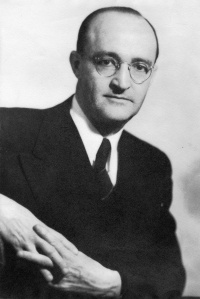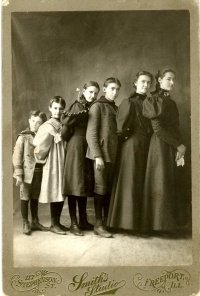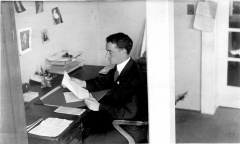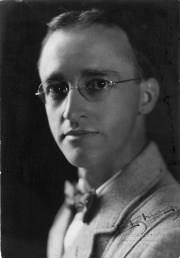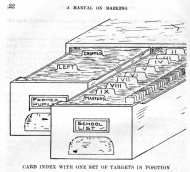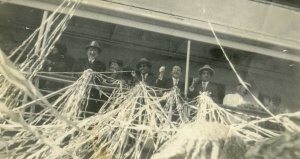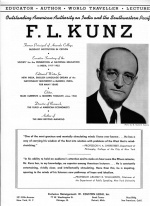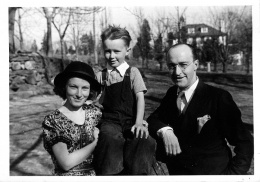Fritz Kunz: Difference between revisions
No edit summary |
No edit summary |
||
| (36 intermediate revisions by the same user not shown) | |||
| Line 1: | Line 1: | ||
[[File:Fritz Kunz 2.jpg|200px|right|thumb|Fritz Kunz]] | |||
[[File:Fritz Kunz 2 | |||
'''Fritz L. Kunz''' (1888-1972) was an American lecturer, educator, editor, and writer associated with the [[Theosophical Society (Adyar)|Theosophical Society based in Adyar, India]]. As a young man he worked with [[Charles Webster Leadbeater]] and [[Annie Besant]], and later he was married to [[Dora van Gelder Kunz]], who served as President of the [[Theosophical Society in America]]. | '''Fritz L. Kunz''' (1888-1972) was an American lecturer, educator, editor, and writer associated with the [[Theosophical Society (Adyar)|Theosophical Society based in Adyar, India]]. As a young man he worked with [[Charles Webster Leadbeater]] and [[Annie Besant]], and later he was married to [[Dora van Gelder Kunz]], who served as President of the [[Theosophical Society in America]]. | ||
When science has exploited everything that it knows, it will show that the universe is harmonic, is charged with principle, and that ethics are not the function of some kind of human decisions. – Fritz Kunz, "Science, Civilization and Human Affairs" [lecture]<ref>Fritz Kunz, "Science, Civilization and Human Affairs" [lecture] Kunz Family Collection. Records Series 25.01. Theosophical Society in America Archives.</ref> | When science has exploited everything that it knows, it will show that the universe is harmonic, is charged with principle, and that ethics are not the function of some kind of human decisions. – Fritz Kunz, "Science, Civilization and Human Affairs" [lecture]<ref>Fritz Kunz, "Science, Civilization and Human Affairs" [lecture] Kunz Family Collection. Records Series 25.01. Theosophical Society in America Archives.</ref> | ||
[[File:Kunz children.jpg|200px|right|thumb|Fritz Kunz, left, with older siblings. Image from TSA Archives.]] | |||
== Early years == | == Early years == | ||
Frederick L. Kunz was born on [[May 16]], 1888 in Freeport, Illinois. He was the twelfth and last child of Frederick John Kunz and Susan R. Knecht Kunz, who were naturalized citizens of German birth. He was usually known as Fritz. Not all of the children survived until adulthood, and the ones shown in the photograph at right are those with whom he spent the most time. From right to left, in descending age, are Alma, Minna, Bill, Litta, Sue, and Fritz. | Frederick L. Kunz was born on [[May 16]], 1888 in Freeport, Illinois. He was the twelfth and last child of Frederick John Kunz and Susan R. Knecht Kunz, who were naturalized citizens of German birth. He was usually known as Fritz. Not all of the children survived until adulthood, and the ones shown in the photograph at right are those with whom he spent the most time. From right to left, in descending age, are Alma, Minna, Bill, Litta, Sue, and Fritz. | ||
Both parents and several older siblings became members of the Theosophical Society soon after attending the [[World's Parliament of Religions (1893)|World's Parliament of Religions in 1893]] in Chicago, and were active in the Freeport Lodge. Fritz was only five years old in the year of the Parliament, and was not allowed to attend, but he was soon engaged in the service of Theosophy by helping with the office work of the lodge. He became a member in 1902. TS lecturers visited the Kunz family in Freeport, and Fritz became acquainted with [[Charles Webster Leadbeater|Charles W. Leadbeater]]. | Both parents and several older siblings became members of the Theosophical Society soon after attending the [[World's Parliament of Religions (1893)|World's Parliament of Religions in 1893]] in Chicago, and were active in the Freeport Lodge. Fritz was only five years old in the year of the Parliament, and was not allowed to attend, but he was soon engaged in the service of Theosophy by helping with the office work of the lodge. He became a member in 1902. TS lecturers visited the Kunz family in Freeport, and Fritz became acquainted with [[Charles Webster Leadbeater|Charles W. Leadbeater]]. | ||
[[File:Leadbeater and secretaries.jpg|right|220px|thumb|Fritz with Leadbeater and Basil Hodgson-Smith, Octagon House, Adyar]] | |||
==Travels with Charles Leadbeater == | ==Travels with Charles Leadbeater == | ||
In 1903 Fritz visited Leadbeater in California, and in 1904 traveled with him on the East coast. In 1905-1906 they went to Hawaii, Samoa, Australia, India, Burma, Ceylon, and Egypt on an extended lecture tour, and home by way of Italy, France, and London. Fritz and a young Englishman, [[Basil Hodgson-Smith]], worked as secretaries to assist Leadbeater with correspondence. | In 1903 Fritz visited Leadbeater in California, and in 1904 traveled with him on the East coast. In 1905-1906 they went to Hawaii, Samoa, Australia, India, Burma, Ceylon, and Egypt on an extended lecture tour, and home by way of Italy, France, and London. Fritz and a young Englishman, [[Basil Hodgson-Smith]], worked as secretaries to assist Leadbeater with correspondence.<ref>Fritz wrote frequent and detailed letters to his family, which are preserved in the Kunz Family Collection, Records Series 25.01, Theosophical Society in America Archives.</ref> | ||
== Education == | == Education == | ||
| Line 22: | Line 21: | ||
From 1908 to 1912, Kunz attended the University of Wisconsin and received a B.A. in English literature. Several family members were in Madison during that period. During his early years young Fritz was very active in tennis, swimming, bicycling, canoeing, camping, hiking, and basketball; and enjoyed Big Ten football games. He attended concerts and had an active social life, but did not join any campus organizations. | From 1908 to 1912, Kunz attended the University of Wisconsin and received a B.A. in English literature. Several family members were in Madison during that period. During his early years young Fritz was very active in tennis, swimming, bicycling, canoeing, camping, hiking, and basketball; and enjoyed Big Ten football games. He attended concerts and had an active social life, but did not join any campus organizations. | ||
In his later years, his professional writing used the byline Dr. Frederick L. Kunz. In the 1930s, he began to sign articles as "Fritz Kunz, M.A.," so it is likely that he earned a master's degree, but the doctorate may have been honorary. | In his later years, his professional writing used the byline Dr. Frederick L. Kunz. In the 1930s, he began to sign articles as "Fritz Kunz, M.A.," so it is likely that he earned a master's degree, but the doctorate may have been honorary. | ||
[[File:Kunz in Krotona.jpg|240px|left|thumb|Fritz Kunz at Krotona]] | [[File:Kunz in Krotona.jpg|240px|left|thumb|Fritz Kunz at Krotona]] | ||
== Work at Old Krotona == | |||
Kunz became one of the first residents at '''[[Krotona Institute of Theosophy]]''' in Hollywood, California, where he assisted [[A. P. Warrington]] for one year with office work and editing periodicals. The president appointed him as one of six General Secretary's Representatives, a group of "helpers" working with the lodges in various regions. Kunz was assigned to work with lodges in California, Utah, Nevada, Hawai'i, and Arizona.<ref>"General Secretary's Representatives" ''The Theosophic Messenger'' 13.9 (June 1912): 514.</ref> Another assignment was as registrar for the first summer school at Krotona, which involved arranging room and board for over one hundred people. Although Kunz enjoyed the work and the adventure of establishing a new institution, he had to leave after a year because he could not afford to work unpaid. | |||
[[File:FLK portrait.jpg|180px|right|thumb|Fritz Kunz]] | |||
[[File:SPNE Marking - student records.jpg|190px|thumb|Recommendations on keeping student records, from ''Manual on Marking'']] | |||
== Principal at Ananda College == | == Principal at Ananda College == | ||
Late in 1913, Leadbeater sent a telegram offering Kunz a position as principal of [[Ananda College]], a Buddhist school founded by Henry S. Olcott in Colombo, Ceylon. | Late in 1913, Leadbeater sent a telegram offering Kunz a position as principal of [[Ananda College]], a Buddhist school founded by Henry S. Olcott in Colombo, Ceylon. During his tenure, from 1914 to 1917, he instituted many improvements at the school, raised funds, and supervised several construction projects. His sisters Alma and Minna and brother-in-law Hervey Gulick joined the school faculty for a time. At Kunz's request, his brother-in-law Hervey Gulick brought an ''Encyclopedia Britannica'' with him from America. It was a treasured resource that only the upper classmen were allowed to use under heavy supervision.<ref>Telephone interview of Sumith Matugama by Janet Kerschner on March 12, 2012. Mr. Matugama, a member of the Milwaukee Lodge of TSA, related stories of his family.</ref> | ||
In Ceylon, as later in India, Kunz supported social and educational reforms with his work in the Ceylon Service League and other organizations. | In Ceylon, as later in India, Kunz supported social and educational reforms with his work in the Ceylon Service League and other organizations. He assisted Sir Pannambalam Arunachalam in writing the famous address "Our Political Needs," delivered on April 2, 1917, that initiated '''Ceylon's independence movement'''. Mr. Kunz became increasingly active in attempting to improve conditions of the lowest level of society. His social activism caught the attention of the British, who called him "stumpy," and "that short little Buddhist American." As the political environment became more volatile, the British suspended the constitution and instituted martial law. One day when a large commotion took place in front of the school, Kunz sent one of the staff out to see what was happening, and Mr. Menon was shot and killed by the British. | ||
When a friend notified him that his arrest by the British authorities was imminent, Kunz fled to India.<ref>Telephone interview of Sumith Matugama by Janet Kerschner on March 12, 2012. Mr. Matugama, a member of the Milwaukee Lodge of TSA, related stories of his family.</ref><ref>Kunz letter confirms some of this. NEED DETAILS FROM ARCHIVES. </ref> | When a friend notified him that his arrest by the British authorities was imminent, Kunz fled to India.<ref>Telephone interview of Sumith Matugama by Janet Kerschner on March 12, 2012. Mr. Matugama, a member of the Milwaukee Lodge of TSA, related stories of his family.</ref><ref>Kunz letter confirms some of this. NEED DETAILS FROM ARCHIVES. </ref> | ||
| Line 44: | Line 41: | ||
In 1921, [[B. P. Wadia]] resigned from the management of the enterprise and Kunz was appointed to succeed him.<ref>"The Theosophical Publishing House," ''The Messenger'' 8.10 (March 1921), 632.</ref> | In 1921, [[B. P. Wadia]] resigned from the management of the enterprise and Kunz was appointed to succeed him.<ref>"The Theosophical Publishing House," ''The Messenger'' 8.10 (March 1921), 632.</ref> | ||
== | == Meeting Dora van Gelder == | ||
[[File:Bon voyage.jpg|right|300px|thumb|A. P. Warrington, Marie Poutz, Nitya, Fritz, Krishnamurti]] | |||
Kunz first visited Sydney, Australia in 1922 when he and [[A. P. Warrington]] stayed with the van Gelder family. [[Annie Besant]] had asked for their assistance during a crisis of the Theosophical Society in Australia in which 600 out of the 900 members in Sydney left to form the [[Independent Theosophical Society]] under the leadership of [[T. H. Martyn]]. Fritz then escorted the ailing [[Jiddu Nityananda]] and his famous brother [[Jiddu Krishnamurti]] to Ojai, California, where the dry climate would be healthier. | |||
In 1924 Dora van Gelder was suffering headaches from a concussion, and Fritz suggested that she travel to Los Angeles for treatment. He took her on visits to Theosophists in Hollywood and Ojai, and they both delivered lectures at the [[American Theosophical Society]] convention in Chicago. | |||
[[File:Fritz Kunz flyer.jpg|150px|thumb|right|Publicity flyer. Image from TSA Archives.]] | [[File:Fritz Kunz flyer.jpg|150px|thumb|right|Publicity flyer. Image from TSA Archives.]] | ||
== Lecturing in the United States == | == Lecturing in the United States == | ||
The early 1920s were a busy time for Kunz. For several years he worked in the United States for the [[Order of the Star in the East]], supporting the idea of [[Jiddu Krishnamurti]] as the [[World Teacher]]. In great demand as a lecturer, Kunz crisscrossed the country making "lantern slide" presentations about Theosophy, India, education, science, and many other subjects. Reviewers acclaimed his skill as a speaker in addressing civic groups, clubs, students, and Theosophical lodges, and his activities were regularly reported in [[The Messenger (periodical)|''The Messenger'']]. He organized [[Young Theosophists|Young Theosophist]] groups and frequently spoke to youth. Many of his non-Theosophical speaking engagements were arranged and publicized through speakers bureaus. | |||
During this period he also turned out numerous articles that were printed in the major Theosophical publications, and worked with [[Marie Russak Hotchener]] and Marjorie Tuttle on OSE's ''The Server''. In 1924 he wrote for a publication called ''The Pacific''. | |||
His life in the 1930s and 1940s followed the same pattern of lecturing and writing, with a great deal of travel and acclaim, but no regular income. | |||
== Marriage and family life== | == Marriage and family life== | ||
[[File:Kunz family in Rye.jpg|260px|thumb|right|Kunz family in Rye, New York. Image from TSA Archives.]] | [[File:Kunz family in Rye.jpg|260px|thumb|right|Kunz family in Rye, New York. Image from TSA Archives.]] | ||
On May 16, 1927 Fritz married Dora van Gelder in a quiet civil ceremony in Chicago. After they married, Dora traveled with Fritz as he toured. She often joked that she had spent her honeymoon at a federal prison in New Orleans, where he lectured. The Kunz family had difficulty at first in accepting the marriage of 23-year-old Dora to 39-year-old Fritz. His sisters Alma, Minna, and Litta were much older and regarded him as the baby of the family. | |||
Just nine months into the marriage, a son, John Kunz, was born in Seattle on February 22, 1928. The family had an apartment in Seattle, but spent much of their time on the road as Fritz lectured for a living. Captain Sellon asked the Kunzes to help in developing the New York Theosophical Society. They became neighbors in Rye, New York, and the two families were very close geographically, socially, and philosophically. | |||
Family life centered on the parents' activities in the Theosophical Society. Their plan for 1931 is a perfect example: | Family life centered on the parents' activities in the Theosophical Society. Their plan for 1931 is a perfect example: | ||
| Line 67: | Line 71: | ||
== Indralaya and Pumpkin Hollow == | == Indralaya and Pumpkin Hollow == | ||
From the early 1930s when they moved to New York, the Kunzes were active in the New York Theosophical Society and various federations. In 1933, Fritz served as president of the New York Federation (later the Northeast Federation).<ref>''The American Theosophist'' 21.9 (September, 1933), 204.</ref> | Fritz and Dora were instrumental in establishing Theosophical retreat centers. In 1927 they were among the first campers at '''[[Indralaya]]''', on Orcas Island in the San Juan Islands near Seattle, Washington; and in 1936 they were among the founders of '''[[Pumpkin Hollow Retreat Center |Pumpkin Hollow Farm]]''' near Craryville, New York. They hoped to start another regional center at an existing facility, '''Camp Cimarroncita''' Taos, New Mexico, in 1931, but it lasted only one season. There was no nearby Theosophical community to support it. | ||
== Academic work == | |||
In the early 1940s, Kunz worked in New York City as Research Director at '''Guild of American Economists''' which he co-founded with Norman Dodd. He spent 1944 and 1945 teaching Asian philosophy, religion, history, and culture at '''Knox College''' in Galesburg, Illinois and at '''Carleton College''' in Northfield, Minnesota, testing his educational materials and methods. The major focus of his adult life was an effort to demonstrate how the ancient principles of Theosophy could be integrated with modern science in the educational system. | |||
== Theosophical Society activities == | |||
From the early 1930s when they moved to New York, the Kunzes were active in the New York Theosophical Society and various federations. In 1933, Fritz served as president of the New York Federation (later the Northeast Federation).<ref>''The American Theosophist'' 21.9 (September, 1933), 204.</ref> While Dora lectured and taught meditation, Fritz organized lectures, workshops, and conferences. He worked on research projects for the New York lodge and for the Foundation for Integrative Education, and continued his involvement with ''Main Currents''. Many projects involved close collaboration with Emily and John Sellon, Dora Kunz, John Kunz, Helen Zahara, Margaret Wagner, William and Shirley Nicholson, Alicia Ripple, William Beller, Alan and Ursula Mannion, Donald Trumpler, and other members of the NYTS. During this period, Kunz pushed to keep the Theosophical Society engaged with new developments in science and education; in this he found more interest and cooperation in the NYTS and Northeast Federation than in the national organization. | |||
== FIE and ''Main Currents in Modern Thought'' == | == FIE and ''Main Currents in Modern Thought'' == | ||
A complex society can only go forward if its institutions are continually improved, so that they operate more and more fully in consonance with the orders of the universe. – Fritz Kunz, "Toward an Institute for Integrative Studies"<ref>Fritz Kunz, "Toward an Institute for Integrative Studies" [proposal] Kunz Family Collection. Records Series 25.01. Theosophical Society in America Archives.</ref> | A complex society can only go forward if its institutions are continually improved, so that they operate more and more fully in consonance with the orders of the universe. – Fritz Kunz, "Toward an Institute for Integrative Studies"<ref>Fritz Kunz, "Toward an Institute for Integrative Studies" [proposal] Kunz Family Collection. Records Series 25.01. Theosophical Society in America Archives.</ref> | ||
The year 1940 saw the establishment of his scholarly journal '''''Main Currents in Modern Thought''''', which served as a forum for scientists and academics. Kunz referred to it as a "journal of integration."<ref>Fritz Kunz letter to John Sellon. See Box 4, Folder 12, Kunz Family Collection, Records Series 25.01, Theosophical Society in America Archives.</ref> Emily Sellon worked with him as co-editor for many years, and Margaret Wagner served as Business Manager. The success of this endeavor in turn led to the establishment of the '''Foundation for Integrative Education,''' a group of scientists, scholars, and businessmen who wanted to improve education by including philosophy, religion, and art with modern science in a cohesive curriculum. Kunz was Vice President, with Kirtley F. Mather as President, John Sellon as Treasurer, Henry Margenau as Director of Research, and Julius Stulman and Samuel P. Wetherill as Board members. The Foundation in turn gave rise to the '''Center for Integrative Education''', which included stellar academicians such as Abraham Maslow, Henry Margenau, Kirtley Mather, F. S. C. Northrop, and Ervin Laszlo among its members. Kunz worked with his son John and others to establish the '''Cuisenaire Company''' as a provider of innovative materials for the teaching of mathematics. | |||
== Later years == | == Later years == | ||
| Line 91: | Line 94: | ||
In 2012, the '''Fritz Kunz Challenge Cup''' or '''Fritz Kunz Memorial Challenge Trophy''' was established as an annual award for citizenship at [[Ananda College]]: | In 2012, the '''Fritz Kunz Challenge Cup''' or '''Fritz Kunz Memorial Challenge Trophy''' was established as an annual award for citizenship at [[Ananda College]]: | ||
<blockquote> | <blockquote> | ||
'''Fritz Kunz Challenge Cup | '''Fritz Kunz Challenge Cup.''' Mr. D. N. W. de Silva, M.B.E., J.P., an Old Boy of the Kunz regime, has just created a new award, the Fritz Kunz Challenge Cup, to be annually awarded to Ananda's Best Young Citizen. It was a happy inspiration that prompted Mr. De Silva to choose this way of honouring Principal Kunz, who never tired of instilling into the minds of his pupils at Ananda the loftiest ideas and ideals of good citizenship.<ref>''Anandaya'' (September, 2012), 2. Available at [http://www.anandacollege.net/document/12092003OBA%20Newsletter%202012%20(3).pdf Ananda College website.]</ref> | ||
</blockquote> | </blockquote> | ||
== Books and pamphlets == | The '''F. L. Kunz Memorial Library''' is at [[Indralaya]], the Theosophical retreat center on Orcas Island in the state of Washington. There is also a Kunz Cabin that Fritz and Dora helped to build in the early days of the camp, and where they stayed when visiting. | ||
== Writings == | |||
=== Books and pamphlets === | |||
When the [[Society for the Promotion of National Education]] was becoming active in 1918, Kunz wrote its '''''Manual for Marking''''', a guide to evaluating student performance. | When the [[Society for the Promotion of National Education]] was becoming active in 1918, Kunz wrote its '''''Manual for Marking''''', a guide to evaluating student performance. | ||
| Line 105: | Line 111: | ||
* [https://archive.org/details/KunzSexConceptsForTheNewAge '''''Sex Concepts for the New Age''''']. Chicago: The Theosophical Press, 1926. A lecture given on September 26, 1926 in Hollywood, California. | * [https://archive.org/details/KunzSexConceptsForTheNewAge '''''Sex Concepts for the New Age''''']. Chicago: The Theosophical Press, 1926. A lecture given on September 26, 1926 in Hollywood, California. | ||
== Articles == | === Articles === | ||
Mr. Kunz was a prolific writer of articles for Theosophical periodicals. The [[Union Index of Theosophical Periodicals]] lists articles published under the name [http://www.austheos.org.au/cgi-bin/ui-csvsearch.pl?search=Fritz+Kunz&method=exact&header=field4 Fritz Kunz] and under the initials [http://www.austheos.org.au/cgi-bin/ui-csvsearch.pl?search=FLK&header=field4 FLK]. Kunz also used pseudonyms during the years 1914-1917 including L. E. Girard, E. L. Girard, S. E. Girard, and Fabius Cunctator, and probably wrote many articles anonymously when he was working for Annie Besant at Adyar. | Mr. Kunz was a prolific writer of articles for Theosophical periodicals. The [[Union Index of Theosophical Periodicals]] lists 151 articles published under the name [http://www.austheos.org.au/cgi-bin/ui-csvsearch.pl?search=Fritz+Kunz&method=exact&header=field4 Fritz Kunz] and others under the initials [http://www.austheos.org.au/cgi-bin/ui-csvsearch.pl?search=FLK&header=field4 FLK]. Kunz also used pseudonyms during the years 1914-1917 including L. E. Girard, E. L. Girard, S. E. Girard, and Fabius Cunctator, and probably wrote many articles anonymously when he was working for Annie Besant at Adyar. | ||
He also contributed many articles to popular magazines and academic journals. | He also contributed many articles to popular magazines and academic journals. | ||
| Line 113: | Line 119: | ||
== Recorded lectures == | == Recorded lectures == | ||
Some lectures are available on compact disc for loan from the [[Henry S. Olcott Memorial Library] | Some lectures are available on compact disc for loan from the [[Henry S. Olcott Memorial Library]]: | ||
* "Akasha". 1970. | * "Akasha". 1970. | ||
| Line 129: | Line 135: | ||
== Additional resources == | == Additional resources == | ||
*[ | * '''Kunz Family Collection'''. Records Series 25.01. Theosophical Society in America Archives. Archival records from the personal lives of Fritz, Dora, and John Kunz, including papers of Basil Hodgson-Smith. | ||
* "Theosophists Who Changed My Life". Audiorecording, 1996. Available from the [[Henry S. Olcott Memorial Library]]. Four theosophists remember others who influenced their lives, including a remembrance of Fritz Kunz by his son, John Kunz. | * '''[https://www.theosophical.org/publications/quest-magazine/in-profound-gratitude In Profound Gratitude]''' by Edward Abdill. Reprinted from ''The Quest'' 92.3 (May-June, 2004): 88. | ||
* '''"Theosophists Who Changed My Life"'''. Audiorecording, 1996. Available from the [[Henry S. Olcott Memorial Library]]. Four theosophists remember others who influenced their lives, including a remembrance of Fritz Kunz by his son, John Kunz. | |||
* [https://www.theosophy.world/encyclopedia/kunz-fritz Kunz, Fritz] in Theosophy World. | |||
== Notes == | == Notes == | ||
| Line 139: | Line 147: | ||
[[Category:Writers|Kunz, Fritz]] | [[Category:Writers|Kunz, Fritz]] | ||
[[Category:Editors|Kunz, Fritz]] | [[Category:Editors|Kunz, Fritz]] | ||
[[Category:Nationality American|Kunz, Fritz]] | [[Category:Nationality American|Kunz, Fritz]] | ||
[[Category:TS Adyar|Kunz, Fritz]] | [[Category:TS Adyar|Kunz, Fritz]] | ||
[[Category:Krotona Hollywood|Kunz, Fritz]] | |||
[[Category:People|Kunz, Fritz]] | [[Category:People|Kunz, Fritz]] | ||
Latest revision as of 15:02, 12 September 2024
Fritz L. Kunz (1888-1972) was an American lecturer, educator, editor, and writer associated with the Theosophical Society based in Adyar, India. As a young man he worked with Charles Webster Leadbeater and Annie Besant, and later he was married to Dora van Gelder Kunz, who served as President of the Theosophical Society in America.
When science has exploited everything that it knows, it will show that the universe is harmonic, is charged with principle, and that ethics are not the function of some kind of human decisions. – Fritz Kunz, "Science, Civilization and Human Affairs" [lecture][1]
Early years
Frederick L. Kunz was born on May 16, 1888 in Freeport, Illinois. He was the twelfth and last child of Frederick John Kunz and Susan R. Knecht Kunz, who were naturalized citizens of German birth. He was usually known as Fritz. Not all of the children survived until adulthood, and the ones shown in the photograph at right are those with whom he spent the most time. From right to left, in descending age, are Alma, Minna, Bill, Litta, Sue, and Fritz.
Both parents and several older siblings became members of the Theosophical Society soon after attending the World's Parliament of Religions in 1893 in Chicago, and were active in the Freeport Lodge. Fritz was only five years old in the year of the Parliament, and was not allowed to attend, but he was soon engaged in the service of Theosophy by helping with the office work of the lodge. He became a member in 1902. TS lecturers visited the Kunz family in Freeport, and Fritz became acquainted with Charles W. Leadbeater.
Travels with Charles Leadbeater
In 1903 Fritz visited Leadbeater in California, and in 1904 traveled with him on the East coast. In 1905-1906 they went to Hawaii, Samoa, Australia, India, Burma, Ceylon, and Egypt on an extended lecture tour, and home by way of Italy, France, and London. Fritz and a young Englishman, Basil Hodgson-Smith, worked as secretaries to assist Leadbeater with correspondence.[2]
Education
Upon returning from his year of travels, Fritz resumed his secondary education at Freeport High School, receiving his diploma in June, 1908.
From 1908 to 1912, Kunz attended the University of Wisconsin and received a B.A. in English literature. Several family members were in Madison during that period. During his early years young Fritz was very active in tennis, swimming, bicycling, canoeing, camping, hiking, and basketball; and enjoyed Big Ten football games. He attended concerts and had an active social life, but did not join any campus organizations.
In his later years, his professional writing used the byline Dr. Frederick L. Kunz. In the 1930s, he began to sign articles as "Fritz Kunz, M.A.," so it is likely that he earned a master's degree, but the doctorate may have been honorary.
Work at Old Krotona
Kunz became one of the first residents at Krotona Institute of Theosophy in Hollywood, California, where he assisted A. P. Warrington for one year with office work and editing periodicals. The president appointed him as one of six General Secretary's Representatives, a group of "helpers" working with the lodges in various regions. Kunz was assigned to work with lodges in California, Utah, Nevada, Hawai'i, and Arizona.[3] Another assignment was as registrar for the first summer school at Krotona, which involved arranging room and board for over one hundred people. Although Kunz enjoyed the work and the adventure of establishing a new institution, he had to leave after a year because he could not afford to work unpaid.
Principal at Ananda College
Late in 1913, Leadbeater sent a telegram offering Kunz a position as principal of Ananda College, a Buddhist school founded by Henry S. Olcott in Colombo, Ceylon. During his tenure, from 1914 to 1917, he instituted many improvements at the school, raised funds, and supervised several construction projects. His sisters Alma and Minna and brother-in-law Hervey Gulick joined the school faculty for a time. At Kunz's request, his brother-in-law Hervey Gulick brought an Encyclopedia Britannica with him from America. It was a treasured resource that only the upper classmen were allowed to use under heavy supervision.[4]
In Ceylon, as later in India, Kunz supported social and educational reforms with his work in the Ceylon Service League and other organizations. He assisted Sir Pannambalam Arunachalam in writing the famous address "Our Political Needs," delivered on April 2, 1917, that initiated Ceylon's independence movement. Mr. Kunz became increasingly active in attempting to improve conditions of the lowest level of society. His social activism caught the attention of the British, who called him "stumpy," and "that short little Buddhist American." As the political environment became more volatile, the British suspended the constitution and instituted martial law. One day when a large commotion took place in front of the school, Kunz sent one of the staff out to see what was happening, and Mr. Menon was shot and killed by the British.
When a friend notified him that his arrest by the British authorities was imminent, Kunz fled to India.[5][6]
Work at Adyar
When he arrived at Adyar, Annie Besant put him to work on many projects. He assisted with the editing of The Theosophist, wrote articles, lectured, and performed any other task needed. He was heavily involved with the Society for the Promotion of National Education during the years when it was forming. In 1918 he wrote the Manual for Marking, a guide for school staff in how to track student performance and maintain school records. He served a role in the management of the National Elementary School, when it was founded in Kilpauk, Madras City, Madras in July 1918.
In 1921, B. P. Wadia resigned from the management of the enterprise and Kunz was appointed to succeed him.[7]
Meeting Dora van Gelder
Kunz first visited Sydney, Australia in 1922 when he and A. P. Warrington stayed with the van Gelder family. Annie Besant had asked for their assistance during a crisis of the Theosophical Society in Australia in which 600 out of the 900 members in Sydney left to form the Independent Theosophical Society under the leadership of T. H. Martyn. Fritz then escorted the ailing Jiddu Nityananda and his famous brother Jiddu Krishnamurti to Ojai, California, where the dry climate would be healthier.
In 1924 Dora van Gelder was suffering headaches from a concussion, and Fritz suggested that she travel to Los Angeles for treatment. He took her on visits to Theosophists in Hollywood and Ojai, and they both delivered lectures at the American Theosophical Society convention in Chicago.
Lecturing in the United States
The early 1920s were a busy time for Kunz. For several years he worked in the United States for the Order of the Star in the East, supporting the idea of Jiddu Krishnamurti as the World Teacher. In great demand as a lecturer, Kunz crisscrossed the country making "lantern slide" presentations about Theosophy, India, education, science, and many other subjects. Reviewers acclaimed his skill as a speaker in addressing civic groups, clubs, students, and Theosophical lodges, and his activities were regularly reported in The Messenger. He organized Young Theosophist groups and frequently spoke to youth. Many of his non-Theosophical speaking engagements were arranged and publicized through speakers bureaus.
During this period he also turned out numerous articles that were printed in the major Theosophical publications, and worked with Marie Russak Hotchener and Marjorie Tuttle on OSE's The Server. In 1924 he wrote for a publication called The Pacific.
His life in the 1930s and 1940s followed the same pattern of lecturing and writing, with a great deal of travel and acclaim, but no regular income.
Marriage and family life
On May 16, 1927 Fritz married Dora van Gelder in a quiet civil ceremony in Chicago. After they married, Dora traveled with Fritz as he toured. She often joked that she had spent her honeymoon at a federal prison in New Orleans, where he lectured. The Kunz family had difficulty at first in accepting the marriage of 23-year-old Dora to 39-year-old Fritz. His sisters Alma, Minna, and Litta were much older and regarded him as the baby of the family.
Just nine months into the marriage, a son, John Kunz, was born in Seattle on February 22, 1928. The family had an apartment in Seattle, but spent much of their time on the road as Fritz lectured for a living. Captain Sellon asked the Kunzes to help in developing the New York Theosophical Society. They became neighbors in Rye, New York, and the two families were very close geographically, socially, and philosophically.
Family life centered on the parents' activities in the Theosophical Society. Their plan for 1931 is a perfect example:
On March 1, Fritz Kunz and Dora van Gelder Kunz and John Kunz leave New York for Seattle by motor car, traveling by way of Philadelphia, Baltimore, Washington, Richmond, Asheville, Atlanta, and Biloxi, at most of which stops public lecturing or other work will be done. Fritz Kunz will then travel by car to New Orleans, Baton Rouge, and Dallas to Oklahoma City, where he will give a sustained course of lectures... for six weeks. During this stay in Oklahoma City he will also be available or work in cities within a night's journey by rail. Invitations may be addressed to Mr. Kunz, c/o Mrs. Josephine Barry, 2210 West Beach, Biloxi, Mississippi.
During the first ten days in June the Kunzes will assist at the Cimarroncita Camp, near Raton and Taos, New Mexico. After this regional camp, in which Mr. and Mrs. Geoffrey Hodson will be principals, the Kunzes proceed to Orcas island, to prepare for and assist in the Orcas island T. S. Camp, which occurs the last two weeks in July. The Hodsons will also attend and assist in this Camp, also Captain and Mrs. E. M. Sellon of New York. The Kunzes will return to New York after autumn work in the northwest.[8]
Indralaya and Pumpkin Hollow
Fritz and Dora were instrumental in establishing Theosophical retreat centers. In 1927 they were among the first campers at Indralaya, on Orcas Island in the San Juan Islands near Seattle, Washington; and in 1936 they were among the founders of Pumpkin Hollow Farm near Craryville, New York. They hoped to start another regional center at an existing facility, Camp Cimarroncita Taos, New Mexico, in 1931, but it lasted only one season. There was no nearby Theosophical community to support it.
Academic work
In the early 1940s, Kunz worked in New York City as Research Director at Guild of American Economists which he co-founded with Norman Dodd. He spent 1944 and 1945 teaching Asian philosophy, religion, history, and culture at Knox College in Galesburg, Illinois and at Carleton College in Northfield, Minnesota, testing his educational materials and methods. The major focus of his adult life was an effort to demonstrate how the ancient principles of Theosophy could be integrated with modern science in the educational system.
Theosophical Society activities
From the early 1930s when they moved to New York, the Kunzes were active in the New York Theosophical Society and various federations. In 1933, Fritz served as president of the New York Federation (later the Northeast Federation).[9] While Dora lectured and taught meditation, Fritz organized lectures, workshops, and conferences. He worked on research projects for the New York lodge and for the Foundation for Integrative Education, and continued his involvement with Main Currents. Many projects involved close collaboration with Emily and John Sellon, Dora Kunz, John Kunz, Helen Zahara, Margaret Wagner, William and Shirley Nicholson, Alicia Ripple, William Beller, Alan and Ursula Mannion, Donald Trumpler, and other members of the NYTS. During this period, Kunz pushed to keep the Theosophical Society engaged with new developments in science and education; in this he found more interest and cooperation in the NYTS and Northeast Federation than in the national organization.
FIE and Main Currents in Modern Thought
A complex society can only go forward if its institutions are continually improved, so that they operate more and more fully in consonance with the orders of the universe. – Fritz Kunz, "Toward an Institute for Integrative Studies"[10]
The year 1940 saw the establishment of his scholarly journal Main Currents in Modern Thought, which served as a forum for scientists and academics. Kunz referred to it as a "journal of integration."[11] Emily Sellon worked with him as co-editor for many years, and Margaret Wagner served as Business Manager. The success of this endeavor in turn led to the establishment of the Foundation for Integrative Education, a group of scientists, scholars, and businessmen who wanted to improve education by including philosophy, religion, and art with modern science in a cohesive curriculum. Kunz was Vice President, with Kirtley F. Mather as President, John Sellon as Treasurer, Henry Margenau as Director of Research, and Julius Stulman and Samuel P. Wetherill as Board members. The Foundation in turn gave rise to the Center for Integrative Education, which included stellar academicians such as Abraham Maslow, Henry Margenau, Kirtley Mather, F. S. C. Northrop, and Ervin Laszlo among its members. Kunz worked with his son John and others to establish the Cuisenaire Company as a provider of innovative materials for the teaching of mathematics.
Later years
Fritz Kunz died on February 13, 1972 in New York, survived by his wife Dora, who later went on to become President of the Theosophical Society in America. Their son John was also very active in the Society.
Honors and memorials
In 2012, the Fritz Kunz Challenge Cup or Fritz Kunz Memorial Challenge Trophy was established as an annual award for citizenship at Ananda College:
Fritz Kunz Challenge Cup. Mr. D. N. W. de Silva, M.B.E., J.P., an Old Boy of the Kunz regime, has just created a new award, the Fritz Kunz Challenge Cup, to be annually awarded to Ananda's Best Young Citizen. It was a happy inspiration that prompted Mr. De Silva to choose this way of honouring Principal Kunz, who never tired of instilling into the minds of his pupils at Ananda the loftiest ideas and ideals of good citizenship.[12]
The F. L. Kunz Memorial Library is at Indralaya, the Theosophical retreat center on Orcas Island in the state of Washington. There is also a Kunz Cabin that Fritz and Dora helped to build in the early days of the camp, and where they stayed when visiting.
Writings
Books and pamphlets
When the Society for the Promotion of National Education was becoming active in 1918, Kunz wrote its Manual for Marking, a guide to evaluating student performance.
In 1937, Kunz saw the publication of his first book. The Men Beyond Mankind: A Study of the Next Step in Personal and Social Emotion (New York: David Mackay, 1937) discusses the evolutionary process that led to humankind, the nature of human consciousness, and the types of beings that will succeed humans. It is available in digital form on a Russian web page.
Another book, Integrative Principles of Modern Thought was to be published by Gordon and Breach in 1970.[13] Kunz died before publication took place, and the work was published in 1972 by Kunz' longtime associate Henry Margenau.
In addition, he wrote several pamphlets, including:
- Sex Concepts for the New Age. Chicago: The Theosophical Press, 1926. A lecture given on September 26, 1926 in Hollywood, California.
Articles
Mr. Kunz was a prolific writer of articles for Theosophical periodicals. The Union Index of Theosophical Periodicals lists 151 articles published under the name Fritz Kunz and others under the initials FLK. Kunz also used pseudonyms during the years 1914-1917 including L. E. Girard, E. L. Girard, S. E. Girard, and Fabius Cunctator, and probably wrote many articles anonymously when he was working for Annie Besant at Adyar.
He also contributed many articles to popular magazines and academic journals.
- "Theosophy" in Dagobart D. Runes Dictionary of Philosophy. New York: Philosophical Library, 1942. Available at Dictionary of Philosophy.
Recorded lectures
Some lectures are available on compact disc for loan from the Henry S. Olcott Memorial Library:
- "Akasha". 1970.
- "Science, Education, and Spiritual Development". 1970.
- "Reminiscences of Annie Besant and C.W. Leadbeater". 1967.
Many additional lectures and informal talks were recorded on magnetic tape reels that are in the Archives Department of the Theosophical Society in America.
Correspondence, pseudonyms, and handwriting
Fritz Kunz engaged in an extensive correspondence throughout his life. He was a proficient typist from his early teens when he was a secretary to C. W. Leadbeater, and tended to type his letters when a machine was available.
In writing to his sisters and friends, he was high-spirited and playful, often using nicknames and pseudonyms. To correspondents, he usually signed as FLK or FK, but sometimes as Lent [significance unknown]. He addressed Alma Kunz as A, Litta Kunz as Lid or Boans, Minna Kunz as Schmidt, and Leadbeater as Uncle. He used pseudonyms in some of his writing for Theosophical periodicals, including L. E. Girard, E. L. Girard, S. E. Girard, and Fabius Cunctator during the years 1914-1917.
Additional resources
- Kunz Family Collection. Records Series 25.01. Theosophical Society in America Archives. Archival records from the personal lives of Fritz, Dora, and John Kunz, including papers of Basil Hodgson-Smith.
- In Profound Gratitude by Edward Abdill. Reprinted from The Quest 92.3 (May-June, 2004): 88.
- "Theosophists Who Changed My Life". Audiorecording, 1996. Available from the Henry S. Olcott Memorial Library. Four theosophists remember others who influenced their lives, including a remembrance of Fritz Kunz by his son, John Kunz.
- Kunz, Fritz in Theosophy World.
Notes
- ↑ Fritz Kunz, "Science, Civilization and Human Affairs" [lecture] Kunz Family Collection. Records Series 25.01. Theosophical Society in America Archives.
- ↑ Fritz wrote frequent and detailed letters to his family, which are preserved in the Kunz Family Collection, Records Series 25.01, Theosophical Society in America Archives.
- ↑ "General Secretary's Representatives" The Theosophic Messenger 13.9 (June 1912): 514.
- ↑ Telephone interview of Sumith Matugama by Janet Kerschner on March 12, 2012. Mr. Matugama, a member of the Milwaukee Lodge of TSA, related stories of his family.
- ↑ Telephone interview of Sumith Matugama by Janet Kerschner on March 12, 2012. Mr. Matugama, a member of the Milwaukee Lodge of TSA, related stories of his family.
- ↑ Kunz letter confirms some of this. NEED DETAILS FROM ARCHIVES.
- ↑ "The Theosophical Publishing House," The Messenger 8.10 (March 1921), 632.
- ↑ "The Kunzes on the March," The Theosophical Messenger 19.3 (March 1931), 338.
- ↑ The American Theosophist 21.9 (September, 1933), 204.
- ↑ Fritz Kunz, "Toward an Institute for Integrative Studies" [proposal] Kunz Family Collection. Records Series 25.01. Theosophical Society in America Archives.
- ↑ Fritz Kunz letter to John Sellon. See Box 4, Folder 12, Kunz Family Collection, Records Series 25.01, Theosophical Society in America Archives.
- ↑ Anandaya (September, 2012), 2. Available at Ananda College website.
- ↑ Letter..... January 1969. Kunz Family Collection 25.01. Theosophical Society in America Archives.
